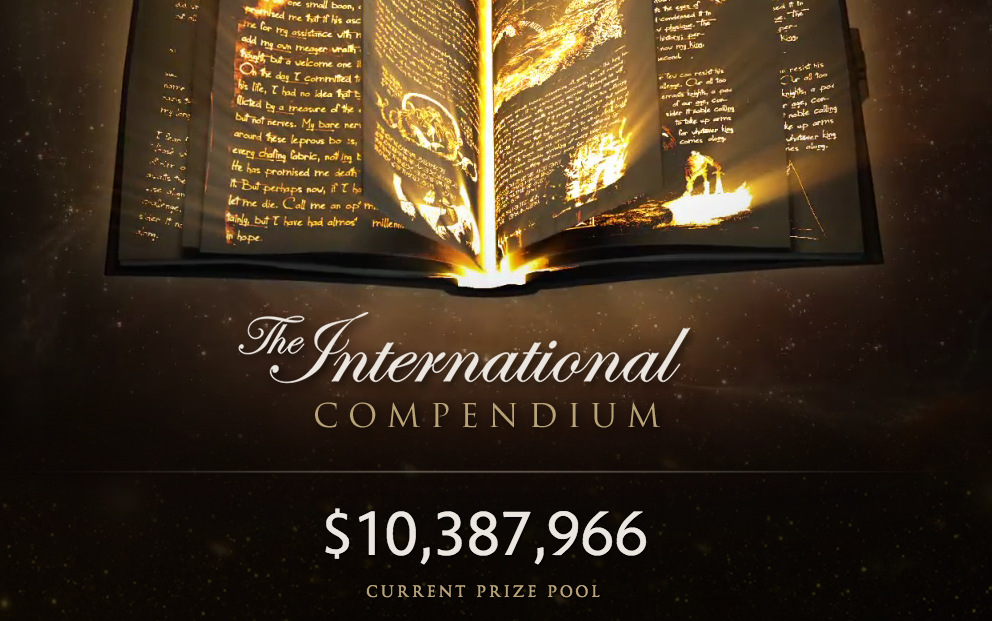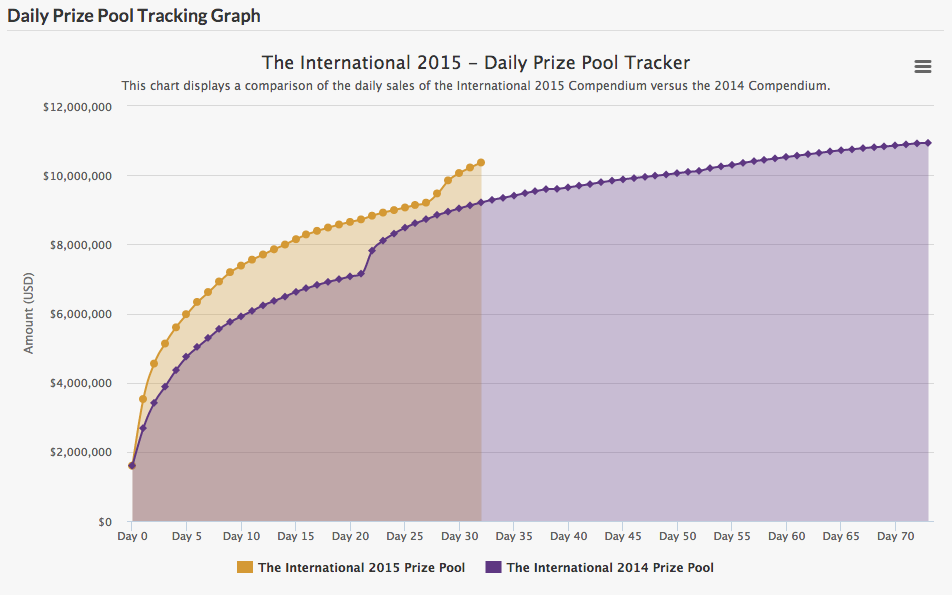10 million dollars.
This year marks Valve’s 5th Dota2 championship: The International. After only one month of fundraising it’s raised a whopping $10 million dollars in prize pool. Dota2 is a multiplayer online game where at its core, five virtual magical characters bash five other virtual magical characters until victory. All watched by 20 million global viewers.
The prize pool is largely crowd funded by selling Compendiums – an in-game item granting various effects. 25% of compendium sales goes towards the prize pool, and players can spend more money for additional benefits. The benefits to the players are good, but this is really about fans of the hugely popular Dota2 engaging with the game’s marquee tournament. Where they get to see the world’s 16 best teams of 5 players from around the world compete for historic money.
A similar League of Legends tournament
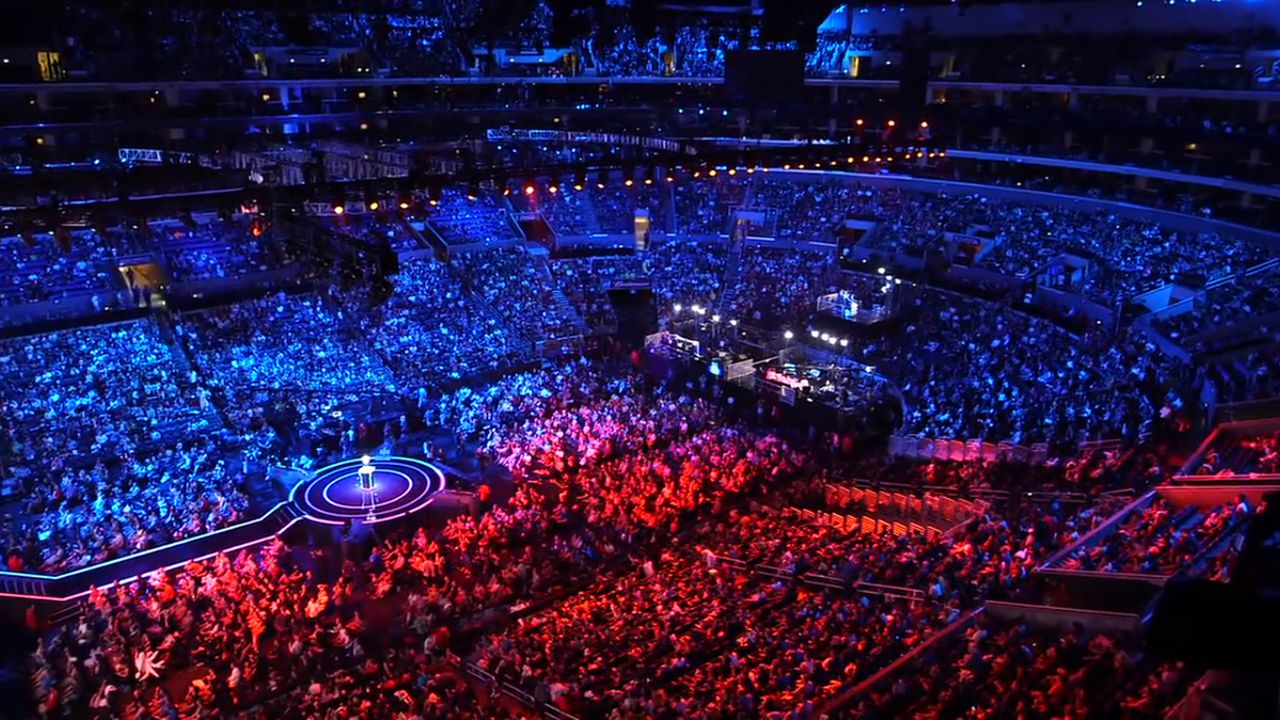
The speed of growth has been immense.
Valve announced their first international for summer 2011 when Dota2 was still in beta. The prize pool of $1.6m was so high compared to the tournaments in the already competitive DotA (the original game that was a mod for Warcraft 3), that some teams thought it was a scam.
In all years Valve started the prize pool at $1.6m, and all additional money was 25% of fan based purchases of in game items.
2011 : $1.6m
2012 : $1.6m
2013 : $2.9m (first year of the compendium)
2014 : $10.9m
2015 looks on course to eclipse the already mammoth $11m from last year’s tournament.
But surely this is nothing compared to traditional sports?
Let’s see how things stack up.
The Wimbledon 2014 singles event for Tennis had $9.6m each for women’s and men’s with a similar number of competing players.
Golf’s 2014 PGA championship had a $10m prize pool for a similar number of players
Poker’s biggest ever tournament (2006 World Series main event) clocked in at $82.5m, but with 100x the players
Cricket’s 2015 World Cup had $10.2m, similar numbers of players
What about one of the largest sporting events in the world? The FIFA World Cup.
The FIFA 2014 World Cup comes in with a whopping $476m (ignoring the injury insurance). But, once you consider the per player numbers, we’re down to an almost modest ~5x difference.
So what?
Of course, this is simplified. What about sponsorships and broadcasting rights? Merchandise? Event tickets? Endorsements? What about events that are the culmination of a season, such as the Champions League, or the NFL’s superbowl, or the NBA Playoffs, or any other number of huge sporting events. The list goes on.
But the point is to demonstrate the already massive scale of competitive gaming and gaming in general. Remember, Dota2 is just one game in a list of many. Take a look at Blizzard’s Starcraft 2, or Riot’s League of legends (with 67m+ monthly players in Jan 2014 – twitter is at 302 million for comparison!) and you can see big tournaments for a huge audience. And if we take a closer look, not only are those other areas of revenue generation doing well in their own rights, but surely as the landscape matures will catch up.
What’s causing the growth?
The game industry itself is huge.
Global revenue of the video game industry was $100B in 2014– nearly 3 times the movie industry. Grand Theft Auto V made $1B in 3 days, while Minecraft was sold for $2.5B to Microsoft. Mobile games are obscenely lucrative. Candy Crush developer – King – made $2.26B in revenue in 2014. Clash of Clans developer made 10x the revenue per employee compared to tech giant Google. League of Legends makes $127m a month.
This doesn’t necessarily all lead to more competitive gaming, but games being thoroughly main stream means that the concept of playing video games is hardly foreign.
Twitch, YouTube and Social Media leads to huge engagement.
Anyone can start posting content online and become wildly popular. In the gaming world, there are real celebrities making huge amounts of money from streaming themselves playing video games. The most notable example is PewDiePie. His 5.9 Million twitter followers puts him firmly with the names of biggest celebrities in the world. The failure of traditional media to capture his popularity merely highlights the shift in reporting that’s happening. Compare Tiger Woods at 4.5M followers. Beyonce at 14M. Kobe Bryant at 6.6M. Rafa Nadal at 7.9M. Leonardo DiCaprio with 12.8M. His instagram account has 4.2m followers. PewDiePie’s youtube account has an utterly ridiculous 37 Million subscribers – by far the most on youtube, holding the top spot since December 2013.
An extreme example, But an extreme example of a real underlying trend. Content is becoming distributed. It’s easier than ever for individuals to reach huge audiences through platforms such as youtube and twitch. Last year, Twitch broke 100M unique monthly viewers, leading Amazon to acquire them for over $1 Billion. When you consider Netflix’s Market Cap of $35B, and the relative size of the video game industry, then perhaps the price of twitch looks almost modest.
The huge viewership means that tournaments of the biggest games have a captive audience. Beyond The Summit, one of many Dota2 studios providing content and streaming commentary for the game’s competitive scene, is Twitch’s 3rd most viewed channel. Their popularity allows them to host $300k tournaments with the best teams in the world. It’s also very common for professional gamers to engage with their fans by streaming themselves playing the game in the regular, non competitive modes – often with commentary. Subscriber and donation money supplement their income and help keep them popular. They can easily engage with fans through Twitch chat, Reddit, twitter and other social media – and can showcase their personality in casual games, while also showing of their skill in comparison to regular players. You can understand the popularity of such streams and the entertainment to their fans by likening it to Ronaldo or Messi broadcasting themselves playing 5-a-side with their friends while joking around.
Gaming is mainstream.
If the above didn’t convince you, last year Twitch released an interesting study titled “The New Face of Gamers”. According to the study, 63% of Americans of all ages have played a game on a console, computer or mobile device in the last 60 days. Gamers are split evenly by gender, lead more social lives than non gamers, and are more highly educated. 59% of gamers had watched more livestreaming content than the previous year, with 36% preferring streaming to conventional TV. At the time of writing. Twitch was responsible for 1.8% of peak internet traffic. Gaming is mainstream.
Ubiquitous fast internet has allowed gaming to move from just escapism and relaxation to widespread competition and a social platform. There’s a generational aspect too, with young fans turning into adults with the disposable income to watch the pros play the games they loved.
OK, it’s huge. Where are we heading? What are the opportunities?
I want to touch on areas that will grow rapidly alongside gaming and e-sports. The examples will bias in favor of Dota2 – as that’s the area I’m most familiar with. Similar and often larger trends can be seen with other games such as League of Legends.
We’re going mobile.
Mobile game are overtaking console games. Traditionally, mobile games have been casual. Angry Birds, Candy Crush, and Clash of Clans rule the market. But there’s room for more competitive, multiplayer, skill based games in the mould of Dota2, StarCraft and Counter Strike. Latencies and bandwidth are increasingly becoming amenable to such types of gaming. It will surely be possible to shrink down a game and simplify the controls, so that the teamwork and strategic awareness is brought out – the real core of a thriving competitive game.
Heartstone was recently released on smart phones, a digital card game made by Blizzard.
/cdn0.vox-cdn.com/uploads/chorus_asset/file/3605148/HS-on-Phone-3.0.png)
The game was already flourishing, with tournaments and large Twitch viewership. Professional player ‘TrumpSC’ peaked at 77k concurrent viewers during April 2015. The turn based nature of the game, with few moving parts relative to other games, makes it perfect for mobile – and will see the game grow beyond the 30M players it already commands.
Allowing regular gamers a deep strategic multiplayer game, during spare moments of the day such as commuting is a hugely untapped market.
We’re talking professional broadcasting and distribution
We’ve talked about the size of Twitch, but there’s also huge levels of production that go into the content covering tournaments. Camera angles, live commentary, statistics, pre and post analysis, player interviews, video and sound control. All traditional areas of sport broadcasting apply. Think ESPN, worth 50B+. A prominent example is Beyond The Summit for Dota2. They send teams across the world to various events to stream them live, building hype and engaging with fans.
An e-sport needs to be entertaining to watch. Traditional sports shine here – they combine accessibility for newcomers (just put the ball in the goal!), with much deeper nuance for regular fans. E-sports are catching up – games like Dota2 have invested a lot in making each ability have unique and distinctive sound effects and animations to make the game easier to follow.


Games have clear indicators in game as to who might be leading, and the quality of accompanying commentary gets more professional and sophisticated every year.
Brands and Pro teams.
If you follow the esports scene – there are certain names that appear frequently across games. Team Liquid, Evil Geniuses, Na`Vi, Fnatic, Cloud9, Invictus Gaming are some of the more well known organisations.
These esports organisations pick up players and teams, who take their name when playing. This has a number of advantages – the organisation name usually has a history in the scene, and so will bring fans and reputability. Perhaps more importantly the organisation will help organise sponsors and travel arrangements to tournaments. It’s fairly common for the organization to pay a salary to the players, helping them focus on their game, and reduce the volatility of prize money earnings. In some cases the salary can be quite substantial, but perhaps more interestingly, some players are finding that streaming can be far more lucrative than playing professionally.
The brand and marketability of these esports teams will only grow in the future. Brands are important for narrative which is important for engagement. Titans, underdogs, long rivalries and drama all create entertaining stories. The audience reach of e-sports will be all about the entertainment value of following teams, players, and tournaments. Creating stories and sharing those with fans is key.
As salaries and budgets grow, we’re also likely to see regulatory bodies similar to traditional sports, helping to keep the scene fair and interesting.
Plenty of Merchandise
We’ve discussed that gaming is larger than the movie industry. Consider that Disney makes $1B a quarter from merchandise from popular brands like Frozen and The Avengers. Disney have huge amounts of experience advertising and distributing their products, and contracts with stores worldwide, but it does give an idea of where the industry might be heading. Is it really so unrealistic to suggest that children would have fluffy real versions of their favorite video game characters over movie characters, given the number of hours they spend playing? Anyone who was at school through the Pokémon craze can attest to how quickly characters from an engaging world can circulate.
But perhaps Disney is the wrong example to learn from. While game creators are slowly catching on, much of the explosion of merchandise is likely to come from decentralised individuals using sites such as Etsy (selling nearly $2B of products on their platform in 2014). The question is how tangential does a product need to be to avoid impinging on the intellectual property of the game creators.
Cosmetics – Digital fashion?
This whole piece has been a discussion of the huge market of games played in a virtual world. These virtual worlds have virtual merchandise too, known as cosmetics. Cosmetics are the primary revenue driver for many games, particularly Valve’s Dota2 and CS:GO. The basic idea is if your character has a sword, then you can show off in the game by purchasing a sword that functions identically, but has flames bursting from the hilt while a golden unicorn dances around the blade. Some people really don’t care, others want to show off how rare and expensive their flaming unicorn dagger is, and others just like it aesthetically. But regardless, it’s a great business model – the game can be free, wildly profitable, and all without negatively affecting game play. Being software, there are endless aspects of the game that can be customised, leading to a very real luxury market. Dota2 in particularly has success with customised weapons, armor, new animations, UI changes, in game voice changes, pets and loading screens.
Items can regularly reach hundreds of dollars, with one Dota2 item in particular reaching $38k. One glance at high end art auctions should convince you that spending on things with aesthetic value can reach large amounts indeed.
Most items, however, are much cheaper, 40c – $2 is common. This puts it firmly in impulse purchase range, where gamers can start spending far more than they realise. Most that spend, however, would tell you that a few dollars spent in a free game was good value for the hundreds or thousands of hours spent playing.
Cosmetics are often designed and created by the community – Valve paid out $57+m to creators of in game items since 2011. 3D modelling skills and tools in the context of gaming will inevitably grow and present many opportunities for making money.
Cosmetics share many similarities with high end fashion brands. As more money and status is tied to games, so will the scale of virtual items. Virtual reality coming to games in the near future that will have a tremendous impact on how virtual characters and their appearances are perceived.
Betting
Traditional sports are no stranger to gambling. The two activities have likely been entwined since the dawn of civilization. In the UK, betting companies such as Ladbrokes and William Hill are very familiar faces among shops – and have a big presence online through competitors like bet365 and Paddy Power – often taking prominent advertising slots for major sporting events.
You’ve guessed where this is going – E-Sports betting is huge, and naturally, growing quickly with the scene. Sites like http://dota2lounge.com/ let you place bets on competitive games by using your in game items – which have a real liquid monetary value due to the steam marketplace. The odds are determined by automatically adjusting based on how people are betting, and usually end up reasonably accurate. If we pick a recent game, such as the final of the European qualifier for The International 2015, we see that ~50500 people placed ~236000 items. This was a popular game, but often there can be dozens of games per day. These are real businesses.
The UI for placing a bet on dota2 lounge (notice the dollar value!)
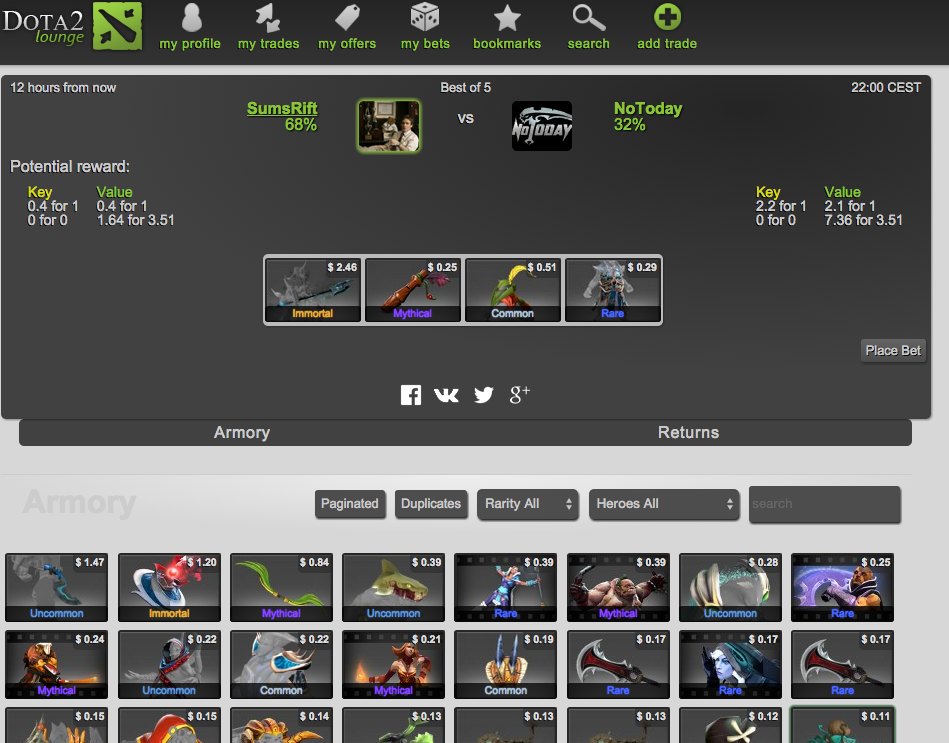
There are other sites too. Vulcun emerged recently – claiming to have paid out $1.6m in the last 3 months, with a $10m total prize pool. It’s a slick website at least, and has seen coverage through major sponsorship of recent teams and tournaments. It works like fantasy sports – allowing you to choose players for your team, and then enter those teams into leagues. Placing highly will win you rewards, and most of the highest rewarding leagues have some sort of buy in.
Vulcun
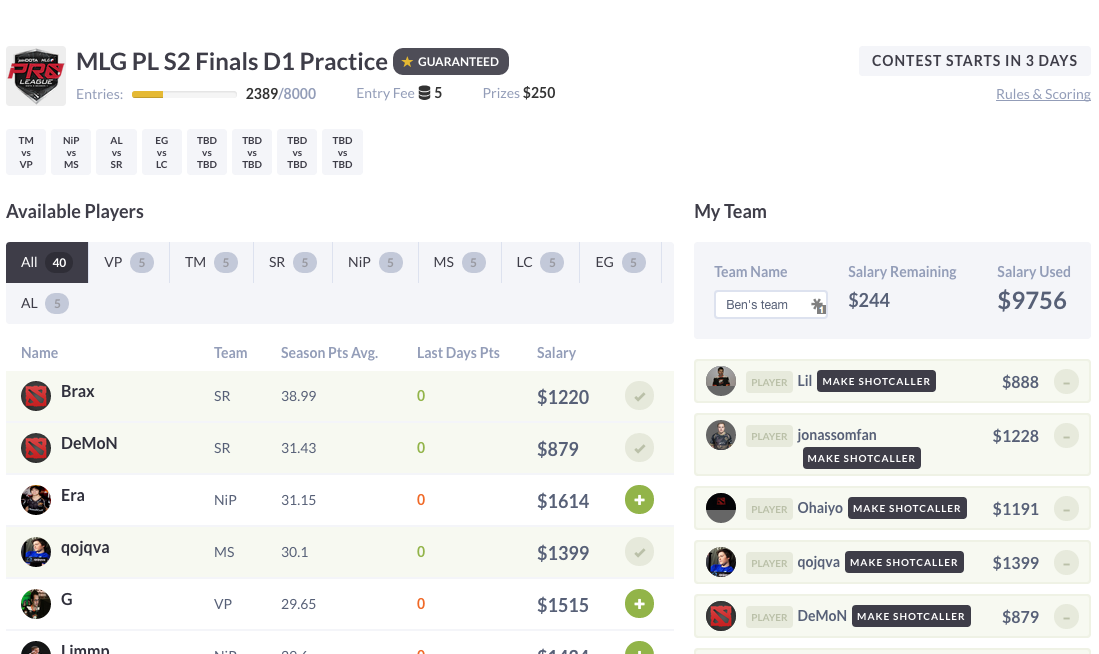
The growth of betting in competitive gaming shows just how engaged fans are. Engaged fans are happy spending large sums to be involved in the storylines created and being part of the community.
And other third party websites.
As the audience grows, all manner of niche third party sites are springing up. Coaching through https://dotacoach.org/. Hugely detailed beginner guides. Extensive community wikis for the game itself and the competitive scene. Countless well written blogs on a variety of topics.
Some sites are very sophisticated and well designed. Dotabuff deserves a special mention. Dotabuff provides detailed analysis and stats for all Dota2 games – it tracks numerous in game metrics that suggest how well you played and can create trends across your games and the entire player base. Think http://www.stats.com/ or http://www.optasports.com/ with a highly explorable modern user-friendly UI. They provide all this for over 140,000 games per day, with all the stats available within minutes from the game ending. (Estimated from their recent games screen). This is real technology providing real value.
Dotabuff



The experience is really quite thorough as an analytical tool for your own games. It lets you filter by character, time played, skill level, match duration and even geographic region – helping you improve your game, or just entertain the stat lovers. This level of polish and attention to detail is the new default for video game related services.
Sites like dotabuff can also help competitive players analyze how their opponents play. As the seriousness of video games increases – the market for tools and similar sites will grow with it.
In summary…
I wanted to give a taste of how I currently see the industry. I’ve barely scratched the surface of opportunities and changes happening. Hopefully I’ve conveyed a tangible sense that this industry is real, growing and to be taken seriously – regardless of whether it’s something that interests you personally. Technology often leads to culture shifts – the key here being – the way society creates and consumes entertainment. Distributed, personal and engaging is the future, and that’s why E-sports are taking off.

